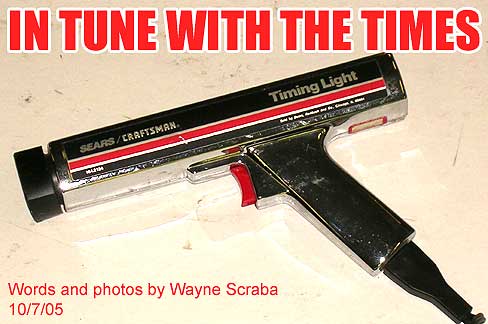| 
“Who cares about timing lights? I’ve timed
the engine in my racecar a thousand times.....it runs the
number.....it doesn't sound like it's detonating....what more
do I need to know...?”
There's no question that timing lights are anvil-basic devices
and are easy to use, but contrary to what you might first
think, all timing lights are not created equal. Before we
get into lights, think about this: The idea behind setting
initial timing is to synchronize the firing "point"
of the ignition with the position of the piston in the cylinder
bore. In order to establish this synchronization, you use
a timing light to determine piston position relevant to a
number of degrees marked on either the harmonic damper or
the timing tab. The only real problem with setting up timing
in this manner is the fact that your timing equipment must
be absolutely accurate. We should also point out that correctly
indexed harmonic dampers as well as properly indexed timing
tabs are crucial.
While it might come as a surprise to most serious racers,
some (no, make that many) timing lights are not accurate!
The reasons are varied, but in the majority of cases, timing
lights have been designed for use in “more pedestrian,
Mom and Pop” applications. Most tune-ups (professional
and otherwise) seldom if ever require that the timing be checked
beyond 2,000 RPM. As a consequence, many timing light manufacturers
are able to construct a very simple, cost effective timing
light.
And the key here is "cost effective". In some instances,
a trigger delay is installed in the light (this practice is
even found in some very high dollar “professional name
brand” lights. I won't name them. Just think mega bucks).
This has little effect in the lower engine speed ranges, but
once the RPM level goes over the 2,000-RPM range, timing lights
with delay circuits appear retarded. Another real problem
is radio frequency noise protection. Most home-use timing
lights have little if any protection against RF noise and
as a result, can produce erroneous readings when used in conjunction
with solid core wire sets.
According to MSD research, certain types of timing lights
with built-in adjusting mechanisms (usually the common “dial
back” models) have been proven to be so inaccurate that
they produce false readings at speeds in excess of several
hundred RPM. Many of these adjustable timing lights also carry
very high price tags. Before you purchase such a unit, compare
it to a known timing light.
So what if your timing light is off a degree or two at 2,500
RPM? While it might sound like a small amount, keep in mind
that whatever error exists in the light at low engine speed
levels will be multiplied as the engine speed increases. If
the light is off by two degrees at 2,500 RPM, it might be
off by six or eight degrees at 6,500 RPM -- and as you can
imagine, that happens to be a significant amount of error.
To determine the accuracy of your particular timing light,
it should be checked against a digital engine analyzer at
speeds below 2,500 RPM. Be certain that your light is installed
properly (see below). Unfortunately, you can’t trust
all digital analysis equipment over the 2,500-RPM ceiling.
Autotronic Controls Corporation (makers of the MSD ignition
systems) recognized this problem and began to test a rather
large number of available timing lights. Through this testing,
they decided to develop their own timing light (P/N 8990).
Additionally, this testing also revealed that an older model
Sears Craftsman Timing Light (P/N A-2134) was considered very
reliable and accurate. Both lights are stable and accurate
from zero to 8,000 RPM and because of this, they are well
suited to a modified (as in “high performance super
rod”) application.
We’ve had the opportunity to test these lamps against
several well know "professional" models and we found
that a few of the other lights were showing much different
timing at engine speeds slightly over 1,200 RPM. At the same
time, the MSD light and the Sears light were virtually identical
in performance. And yes, these two lamps compared favorably
with a digital engine analyzer below 2,500 RPM.

|
